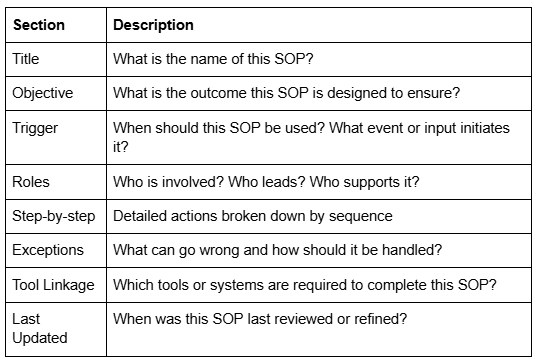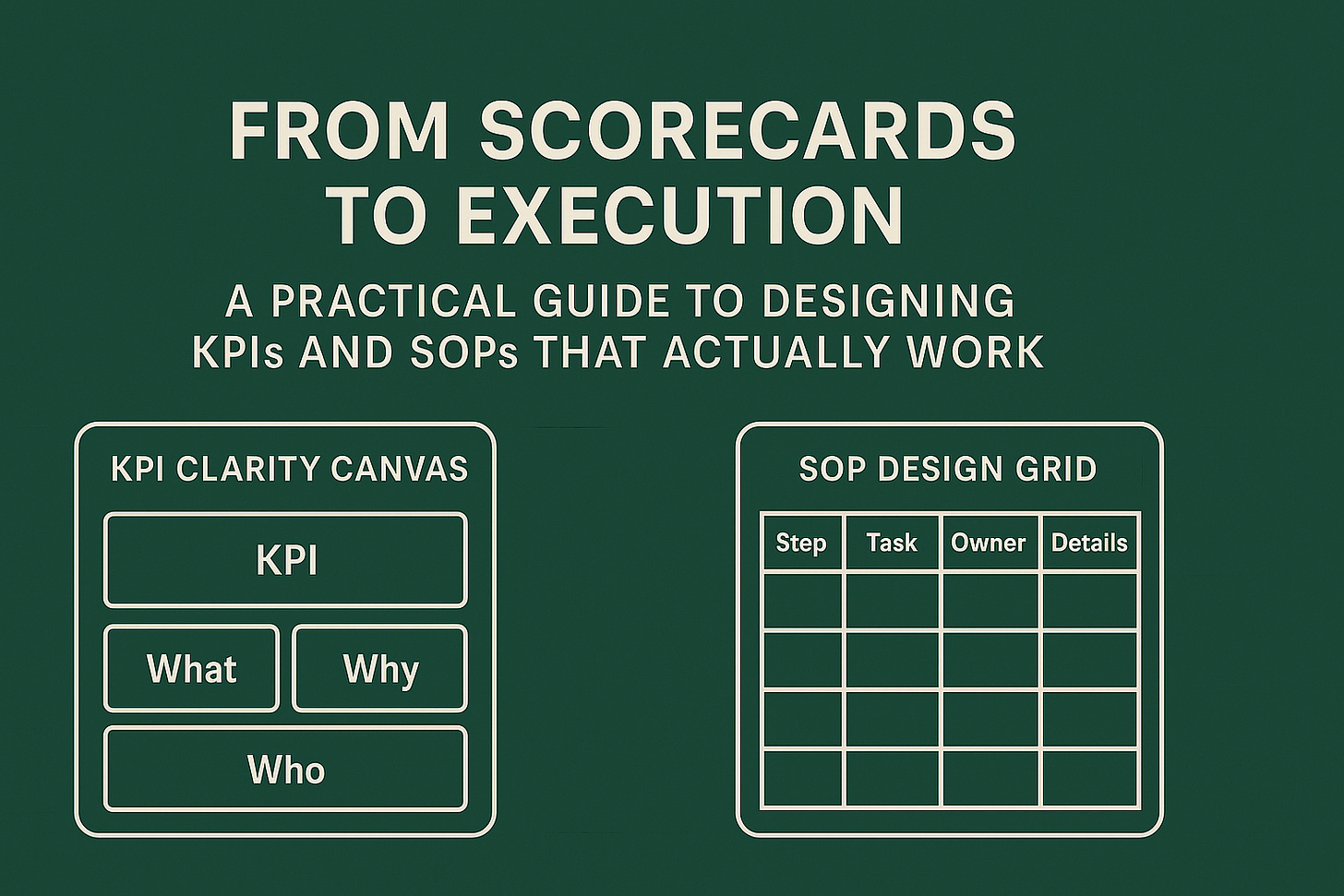From KPIs, SOPs and Scorecards to real Execution: A Practical Guide and a Ready-To-Use Tools
I remember learning about the concept of Balanced Scorecard during my time at IIM Raipur, which helped me understand how different verticals of the organization like Operations, Finance, HR and Marketing interact with each other in a single canvas. But in application? Didn't seem to be that simple and straight forward.
A few years later, in my professional life I understood that the scorecard is not the problem, but the challenge is to how we bring the scorecard alive and engage the way it is supposed to be in theory.
This work here is a pure and practical playbook which has the basis of working with people with years of experience who have known what works and what doesn't when it comes to creating levers of performance out of KPIs and SOPs. This guide is something which you can start applying immediately from your next work day.
The Real Reason KPIs and SOPs Often Fail
It's a huge assumption that once the KPIs are defined and SOPs are documents, execution will be smooth and will happen automatically. But the reality is different. KPIs often do not work because they are too broad, which are designed for quarterly reviews rather than daily decision making at individual and business levels. The defined targets might look great on paper, but they don’t guide what someone should do on any Thursday afternoon.
Another major gap here is the sense of Ownership. Whenever there are multiple owners to a KPI, everyone assumes someone else will drive it. And it gets more challenging when the KPI owner doesn't have any control or influence over the metric output, and that's when the KPI sheet becomes a frustrating scorecard instead of a useful indicator of progress.
And the most important but the most ignored aspect to consider here is the purpose. Without a clear bridge between KPIs, SOPs and purpose, it would all be just in papers. KPIs would feel like a quarterly ritual, and SOPs as a tickbox item.
A Simple Framework That Actually Works
In working with teams across functions, I’ve seen a simple 3-part structure bring KPIs and SOPs to life.
First, define the what. What exactly are we measuring? This must be an outcome, not an activity. Instead of counting the number of list items in the Program initiatives tracker, ask what those initiatives are supposed to achieve. Is it a conversion rate? Is it a resolution time?
Second, define the who. A KPI must be owned by someone who has actual control over the outcome. When one person owns a metric instead of multiple owners, that one person can lead and work with others to deliver with their scope of influence —but the buck stops with them.
Third, link the why. When people understand why something is being measured and how it contributes to the larger organizational goals, their progress and velocity to deliver changes. A well-explained KPI can feel like a personal mission rather than a bureaucratic demand.
The KPI Clarity Canvas (Tool #1)
This is a handy tool I designed which can be used when designing KPIs for teams:
Before finalizing any KPI, answer these six questions. If you can’t answer one clearly, it’s likely not a living KPI.
One of such use cases I was involved in a few years back is from a consumer durables company selling appliances through offline retailers, there was inconsistent reporting and performance in store-level sales activation. Everyone knew that store visibility and promoter effectiveness were key—but they weren't measured clearly.
Using the KPI Clarity Canvas, the team designed a KPI:
Outcome: Achieve >20% monthly sell-out growth from A+ outlets.
Ownership: Assigned to the Branch Manager.
Control Levers: Frequency of store visits, training quality of promoters, availability of display units.
Frequency: Tracked monthly with weekly checkpoints.
Visibility: Added to regional dashboards shared in review meetings.
Motivation: Performance-based incentives + visibility in zonal leaderboard.
The KPI became a lever not just for revenue but for structured sales enablement.
SOPs as Enablers, Not Paperwork
Standard Operating Procedures are not just documents; but they are the bridges to achieving KPIs and other Organizational goals. They help turn thought into action and strategy into workflow. But for them to work, they need to be practical.
SOPs should be visual, time-bound, and specific. A checklist is often more effective than a paragraph. The person executing the task should be able to pick it up and understand exactly what to do, when to do it, and how to know it’s done well, and ideally the deliverable should be 100% under the control of the owner.
More importantly, SOPs should live where the work happens—inside tools, on dashboards, or integrated with workflows. They should evolve with time and adapt to feedback. A good SOP reduces cognitive load and unit level complexity, and builds consistency.
SOP Design Grid (Tool #2)
Use this grid when designing SOPs with your team:
Treat the SOP as a living document. Just like strategy, it must adapt to change.
In the same consumer durables company, after sales product complaints were increasing due to miscommunication at the point of sale. Customers were misinformed about product compatibility or usage, leading to dissatisfaction and returns.
The SOP Design Grid was applied to create a "Promoter Sales Communication SOP":
Title: “Promoter Sales Pitch & Customer Verification SOP”
Objective: Ensure accurate communication of product specs and installation needs.
Trigger: Customer shows interest in a product.
Roles: Promoter, Area Sales Manager, Service Coordinator.
Step-by-step: Greet → Demo → Explain compatibility → Fill checklist → Capture contact details → Confirm installation visit.
Exceptions: If a customer is unsure, flag for callback by senior.
Tool Linkage: CRM app + sales checklist form.
Last Updated: Reviewed every 2 weeks based on NPS and returns data.
Within one quarter, product complaint rates dropped by and post-sale service calls reduced significantly.
How This Aligns With the Balanced Scorecard
The Balanced Scorecard which I learned during my MBA is still a powerful framework. Its four pillars—Financial, Customer, Internal Process, and Learning & Growth—offer a holistic view. But these pillars come alive only when paired with clear KPIs and usable SOPs.
For instance, under the Financial pillar, we might track net margin per product. But unless there's an SOP to guide pricing approvals or control discounts, the KPI becomes hard to influence. Similarly, an Internal Process KPI like average onboarding time only improves if there's a solid SOP for the hiring-to-onboarding flow.
Each pillar can be activated with just one or two strong metrics, each tied to an actionable SOP.
Making It All Work
Good KPI and SOP design is not enough. These systems need to live and breathe inside the organization as a daily guide to action items and critical decision making. Start small—with one team or one process. Test a few KPIs. Run a live SOP. Discuss it weekly. Use feedback to improve.
When people see that KPIs impact decisions—promotions, bonuses, recognition—they start to care. When SOPs help them save time or avoid mistakes, they adopt them willingly. Over time, this becomes culture.
The Balanced Scorecard helps you see the whole map. KPIs and SOPs help you walk it—one confident, trackable step at a time.
Most teams don’t fail because of lack of talent or effort. They fail because the path is fuzzy.
Structure + Ownership + Clarity = Performance That Scales
Here the aim is to build organizations where performance doesn’t need to be forced. It just flows.
For those who want a deeper dive into how KPI reports work and how to make them actionable, I recommend this excellent read by Cascade: https://www.cascade.app/blog/kpi-report
Also, I wrote about Balanced Scorecards few years back which again would be good to read to understand better: https://medium.com/@opjha20/balancing-your-business-performance-with-balanced-scorecard-2ad746ca6e26
If this resonates, share your own KPI or SOP design rituals in the comments—or forward it to someone trying to make strategy feel real.
#KPIs #Execution #BalancedScorecard #StrategyToExecution #OrganizationalPerformance





